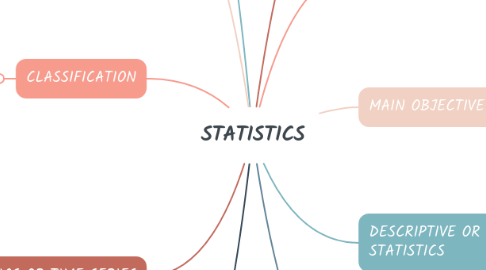
1. INDUCTIVE STATISTICS OR INFERENCE
1.1. It is the phase that involves the analysis that seeks to reach conclusions regarding a larger group or population, based on information from a smaller group or sample.
2. PURPOSE OF ANALYTICAL STATISTICS
2.1. It serves to provide explanations for the behavior of a set of observations, test the validity of the results and seeks to discover the causes of their origin; it relies on sampling to achieve results that go far beyond being statistical. In conclusion, descriptive-analytical statistics is a systematic set of procedures used to observe and describe a phenomenon by means of numbers; it also reveals the laws that regulate the appearance, transformation and disappearance of these phenomena.
3. CLASSIFICATION
3.1. STATISTICS OR PRIMARY SOURCES
3.1.1. Data obtained through direct surveys; either from questionnaires or as a product of direct observation, a technique frequently used in scientific studies or in market research, such as:
3.1.1.1. - Personal (interviews, mail, experiments) - Unipersonal (audit, traceability or - content analysis, simulation) Mixed (comments)
3.2. STATISTICS OR SECONDARY SOURCES
3.2.1. The data are obtained from publications and can be reproduced in whole or in part; they are of great assistance for different types of research, such as:
3.2.1.1. - Libraries - Documentation centers - Brochures - Magazines - Files
4. STATISTICS OR TIME SERIES
4.1. Also known as time series or chronological series, the data are obtained and ordered chronologically and are produced according to the passage of time, whether days, months, semesters or years. If an investigation is carried out in an isolated, non-periodic manner, they are called "atemporal investigations".
5. PURPOSE OF STATISTICS
5.1. - To know the reality of an observation or phenomenon - Determine what is typical or normal for that observation - Determine the changes presented by the phenomenon - Relating two or more phenomena - Determine the root causes of the phenomenon - Make estimates on the future behavior of the phenomenon - Draw conclusions from a smaller group (sample).
5.1.1. In general, its purpose is to provide information and its application will depend on the purpose for which it is intended and the way in which the data is collected.
6. STATISTICS
6.1. It is the discipline that studies the behavior of facts or phenomena as a whole through the collection of information in an orderly and continuous manner with the purpose of determining or choosing the necessary data to carry out the investigation or study of what happened, what happens or may happen; for this, a method or set of principles is required to facilitate the observation, ordering, quantification and analysis of the phenomena.
7. APPLICATION
7.1. In everyday life, in the variety of social, economic, political, educational and even biological phenomena.
8. MAIN OBJECTIVE OF STATISTICS
8.1. Make inferences regarding statistical values of the population; called parameters through the information collected by means of a sample that facilitates the calculation of estimators.
9. DESCRIPTIVE OR DEDUCTIVE STATISTICS
9.1. This is the phase that deals with the description of a set of data without drawing conclusions or generalizing with respect to a larger group.
10. PURPOSE OF DESCRIPTIVE STATISTICS
10.1. To show characteristic aspects of the group, they serve to make comparisons without determining some type of conclusion in general; such as:
10.1.1. - Averages - Data variability
10.1.1.1. Generally, it is carried out by means of: - Charts - Graphics - Calculation of averages - Proportions - Variances of one or more related variables
